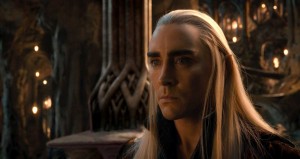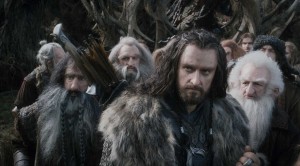
For Peter Jackson‘s The Hobbit: The Desolation of Smaug, costume designer Ann Maskrey turned to the annals of history for inspiration. Maskrey’s work can be seen in the first of the trilogy, The Hobbit: An Unexpected Journey as well as the upcoming final film, The Hobbit: There and Back Again.
This time around, the adventure travels to two new places not yet seen in the other films, nor in The Lord of the Rings trilogy, such as Mirkwood – a forested region of Middle Earth and just to the east, the small settlement of Laketown. The two locations were filled with new characters for Maskrey to dress in imaginative ways. “It was very different and also very enjoyable,” said Maskrey. “Peter was very keen to have a melting pot of cultures in Laketown. Basically, they had to come from a cold place. But it could be a complete melange of places like Tibet and Russia, Mongolia and Inuit culture. That’s where I got my initial references from, anywhere cold where people had to wrap up. Also, the way people wrapped themselves up in Burma, and we did look at fishing cultures too. So the inspiration did come from across the globe.” All the references were then muddled to achieve a particular, indistinguishable look for the people of Laketown.

Maskrey’s favorite character to dress in the film is found in Mirkwood. Thranduil, King of Mirkwood (Lee Pace), is robed in stunningly beautiful fabrics that the costume designer found in her favorite fabric store in London. Much of the fabric was made also from the costume department’s very own textile workshop. “Apart from the fact that he looks great and I’m very happy with his costumes, I brought something to represent the costume to the director and producers and they were very happy with it. That’s the best thing for me when it happens,” she said.
 Collaboration played a major role in costuming The Hobbit: The Desolation of Smaug. Maskrey enjoyed the open communication and sharing of ideas on the hectic and large production which really helped shape the new characters in part two of the trilogy. Additionally, there were two other essential members of the design team. Richard Taylor is the creative director of Weta Workshop that is in charge of the armor, weapons and prosthetic design. “In Desolation of Smaug, all those unpleasant characters like the Orcs, are entirely produced, art-worked and conceptualized by Weta Workshop,” explained Maskrey. Bob Buck rounded out the team by swinging both departments when it came to costume design for the characters created by Weta Workshop.
Collaboration played a major role in costuming The Hobbit: The Desolation of Smaug. Maskrey enjoyed the open communication and sharing of ideas on the hectic and large production which really helped shape the new characters in part two of the trilogy. Additionally, there were two other essential members of the design team. Richard Taylor is the creative director of Weta Workshop that is in charge of the armor, weapons and prosthetic design. “In Desolation of Smaug, all those unpleasant characters like the Orcs, are entirely produced, art-worked and conceptualized by Weta Workshop,” explained Maskrey. Bob Buck rounded out the team by swinging both departments when it came to costume design for the characters created by Weta Workshop.
It was a challenge to travel to New Zealand, where the film is shot, and run the costume department, which was comprised of so many local artists. “The way of working is very different from the way I am used to. I’m not saying it’s wrong. It’s just a different approach. There wasn’t really time to get to know that. You kind of have to get to know it as you go along. Not only did I not know my staff, I didn’t know their way of working.” Nevertheless, the craftspeople and artists were all very talented when it came to making all designs from scratch and the effort was as challenging as it was rewarding for Maskrey. “I loved it,” exclaimed Maskrey regarding the experience.





